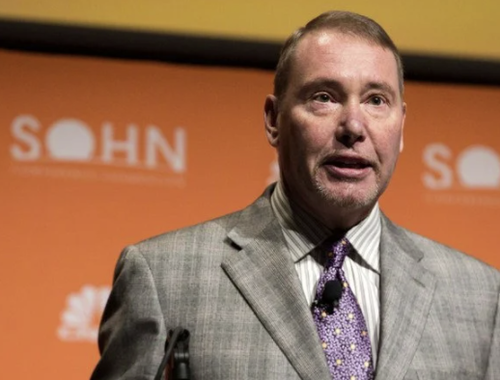Want To Stick It To Coastal Elites? Use Bitcoin
Authored by Avik Roy via AmericanMind.com,
The digital money revolution is happening—which side of it are you on?
Aspiring Republican politicians and conservative opinionators love talking in darkened tones about the malevolence of elites. And yet, for all the fingers wagged and pixels rendered, conservatives have largely ignored the most economically significant way in which elites actually have rigged the game in their favor. The widening gap between elites and the rest of us comes down in large part to the highly abnormal way in which the United States has defined money for the last 50 years.
Our story begins when Richard Nixon—self-styled tribune of the “silent majority”—tore up the Bretton Woods agreement that had linked the value of the U.S. dollar to the price of gold. In 1944, the Allies had all agreed to fix their own currencies’ exchange rates to the U.S. dollar, based on the American promise that the greenback would maintain its peg to the value of 1/35th of an ounce of gold.
The problem for Nixon was that, by 1971, the rest of the industrialized world held $64 billion worth of claims on the $10 billion of gold that the U.S. actually held. Nixon solved this problem in banana republic fashion, abruptly prohibiting foreign countries from redeeming their dollars for gold and, eventually, abandoning the dollar-to-gold peg altogether.
For a period of time, this tactic appeared successful. Nixon got reelected in a landslide in 1972. But within eight years, the dollar’s value in gold terms had declined by 95%, and the greenback’s purchasing power, as measured by the Consumer Price Index, had been cut in half.
WTF Happened?
Many of the economic trends that conservatives now decry stem directly from Nixon’s abandonment of the Bretton Woods agreement. A colorful website, wtfhappenedin1971.com, compiles a long list of them: most notably, that while the benefits of economic growth were widely shared among all Americans between 1945 and 1971, after the Nixon Shock, they accrued far more to the wealthy.
James Grant, the eminent financial commentator, describes interest rates as “the most consequential prices in capitalism.” Low interest rates make it cheaper to borrow money. Cheaper borrowing—“easy money” in financial parlance—may seem like it benefits everyone, but it doesn’t. Instead, it particularly benefits the most creditworthy individuals and institutions, those who already have the ability to borrow in large amounts: banks, investment funds, corporations, and the wealthy.
And so, contrary to conventional wisdom on the Left and some outliers on the Right, the spectacular growth of wealth inequality is not due to “market fundamentalism.” It’s instead due to unprecedented federal interference in the interest rate market, a form of dirigisme that directly follows from the Nixon Shock.
In a truly free market, interest rates are determined by billions of independent decisions by lenders and borrowers. Interest rates go up when lenders fear that they won’t get their money back, and interest rates go down when lenders worry less about that problem.
In contemporary America, interest rates are not determined by the market. They are dictated by the Federal Reserve. And the effects on our economy are profound. When the Fed lends money to banks at near-zero interest, those banks then put the money in investable assets, like bonds, stocks, and real estate. Artificially juicing the demand for such assets benefits those who already have them; that is, those with the biggest homes and the largest investment portfolios. It used to be that every middle-class American could afford to own a home. Not anymore, thanks to the run-up in home prices driven by Fed-fueled real estate inflation.
The primary method by which the Fed controls interest rates is by manipulating the market for Treasury bonds. These bonds are essentially slices of the federal debt; when you purchase a $100 Treasury bond, you are effectively lending the U.S. $100. The lower the bond price, the higher the interest rate, and vice versa.
Hence, the Fed artificially lowers interest rates by going into the bond market and buying trillions of dollars’ worth of U.S. debt, making it seem like there is great demand to lend money to America, when in fact that demand is declining among outside investors.
This artificial manipulation of supply and demand by the Fed leads to a critical question: how does the Fed get the money it needs to buy up all the debt issued by the Treasury department? By printing it out of thin air.
Cheap Debt
In case I’ve made your head hurt, I will try to summarize in plainer English.
The U.S. has incurred $30 trillion of debt. The U.S. borrows money by issuing Treasury bonds. Not enough investors believe that lending money to the U.S. yields an attractive return, and therefore, not enough investors are buying Treasury bonds. In a truly free market, that set of circumstances would lead interest rates to rise.
But if interest rates rise, the government would face higher borrowing costs to finance its debt. And every economically elite American would also face higher borrowing costs, leading to a contraction of markets where financial institutions and wealthy individuals park their excess borrowed cash: the stock market, the venture capital market, the private equity market, the bond market, and the housing market.
How does this relate back to Nixon and 1971? Because none of this borrowing would be possible if the U.S. dollar were still pegged to gold. Under a gold peg, the Fed wouldn’t be able to artificially increase the quantity of U.S. dollars in circulation without also increasing the quantity of gold it held in reserve.
For most of the past 50 years, there was little that the average American could do to protect himself from this vicious cycle. If you did the “responsible” thing, living within your means, but didn’t have enough to invest in the stock market, your savings declined in value. Even if you made enough to put money in a 401(k), rules promulgated by the Securities and Exchange Commission restrict the best investment opportunities to “accredited investors”: those with annual incomes over $200,000 or net worths over $1 million.
The increasing concentration of capital has enabled an important manifestation of cancel culture, in which coastal elites and the government have increasingly gained the capability to deplatform those whose attributes or views do not comport with those of coastal elites. The most recent example of this phenomenon has occurred in Canada, where citizens have been told that their bank accounts will be frozen if they express support for truckers protesting their government’s vaccine mandates.
Digital Gold
Bitcoin, analogous in some important ways to gold, has emerged as a forceful challenger to all of these trends.
To take one point of comparison: like gold, the amount of Bitcoin is finite and fixed. Unlike the U.S. dollar, whose quantity increases every time the Fed snaps its fingers, Bitcoin’s software architecture prevents its circulating supply from ever exceeding 21 million. Hence, over the long term, Bitcoin is inflation-resistant: its purchasing power is actually increasing relative to the dollar. Since Bitcoin came online in 2009, its Sharpe ratio—a measure of volatility-adjusted returns widely used by investors—exceeds that of every other asset class in the world.
Much as the dollar is divisible into 100 cents, each Bitcoin—worth approximately $38,000 at the time of writing—is divisible into 100 million “satoshis,” making an investment in Bitcoin accessible to anyone with even a few dollars in savings to spare. And because the federal government has classified Bitcoin as “property,” not a “security” under the jurisdiction of the SEC, anyone in any income bracket can own Bitcoin.
These two features enable ordinary Americans to protect themselves from the trends that make everyday life more expensive for everyone other than the wealthiest. As the U.S. debt skyrockets, and the Fed prints ever-greater amounts of money to fund it, Bitcoin helps people protect their savings from a government-driven erosion of their purchasing power.
And it’s not just Americans who benefit from Bitcoin. Alex Gladstein of the Human Rights Forum calculates that over 1.4 billion people around the world are living in countries where inflation exceeds 10% per annum, including citizens of Brazil, Turkey, and Argentina.
Satoshi vs. the Fed
Bitcoin skeptics commonly complain that if Bitcoin can do all of these things, then surely the government will ban it. This gets us to one of Bitcoin’s most important qualities.
Bitcoin is uncensorable, meaning that any person with an internet connection can send it to someone else, irrespective of whether or not the government wants them to. Elizabeth Warren and Janet Yellen have complained vigorously about this “problem,” arguing that only criminals would want to trade in a currency that the government doesn’t control.
But precisely because governments cannot cancel it, Bitcoin enables regular people and political dissidents alike to protect themselves from governments’ economic mismanagement. That is not to say that governments can’t make it hard to use Bitcoin. The U.S. could tax Bitcoin-driven capital gains at a punitive rate, like 80%, driving many investors away from the asset. The government could make it difficult for Americans to exchange their U.S. dollars for Bitcoin, through restrictive banking regulations.
Most dangerously, some senior officials in the Biden administration and at the Federal Reserve are considering developing a crypto version of the U.S. dollar, called a “central bank digital currency,” that is exactly the opposite of Bitcoin. A CBDC would enable the federal government to wipe out the private banking sector, because every savings and checking account could reside at the Fed. The federal government would gain the direct authority to add or subtract deposits in those accounts, or even shut them down.
Some people still send handwritten notes and read the print copy of their local newspaper. But in a CBDC world, there won’t be an option to use plain old paper cash. China is rolling out their own CBDC for the Winter Olympics, with the aim of eventually abolishing paper money.
In other words, the digital monetary revolution unleashed by Nakamoto is here to stay. The only question is whether or not the money of the future will serve the interests of governments and elites, or of ordinary people. Bitcoin is resolutely on the side of the latter.
Tyler Durden
Sat, 02/26/2022 – 18:00
via ZeroHedge News https://ift.tt/Ja0H3SL Tyler Durden











